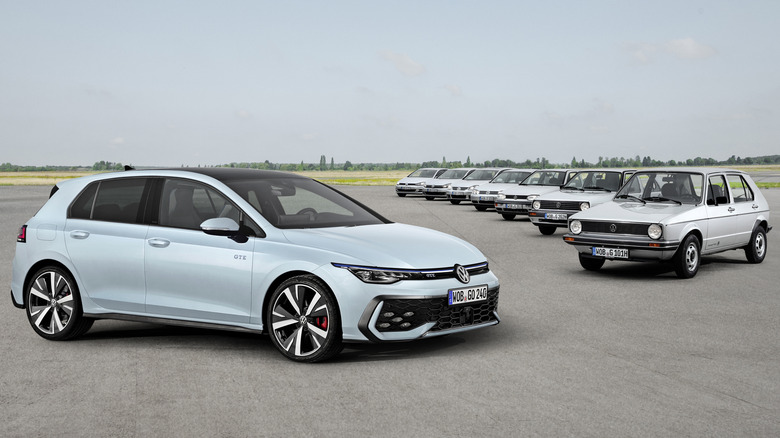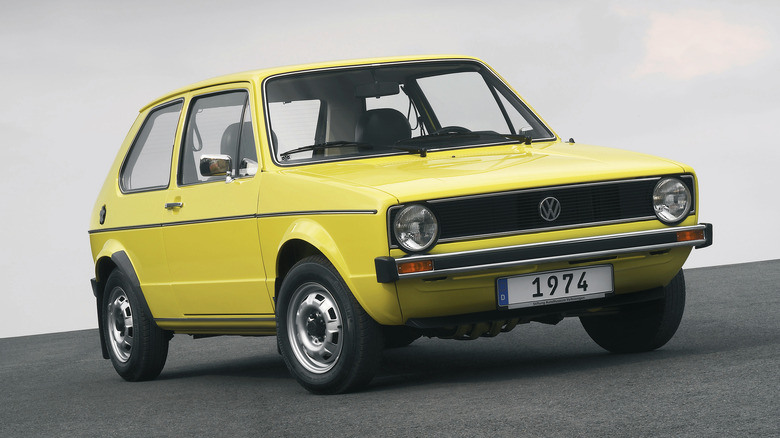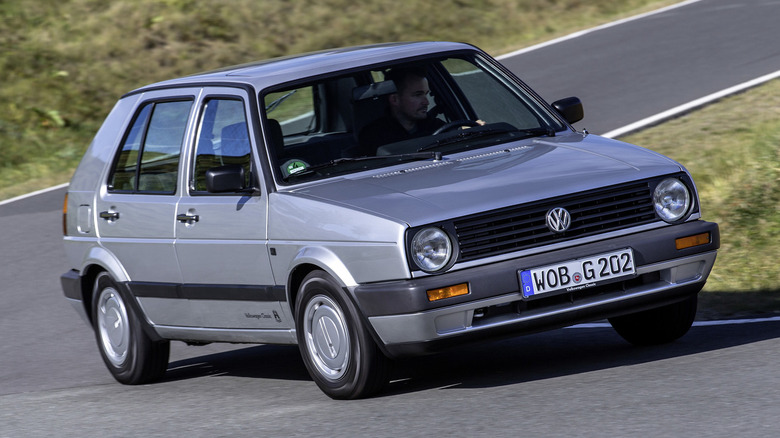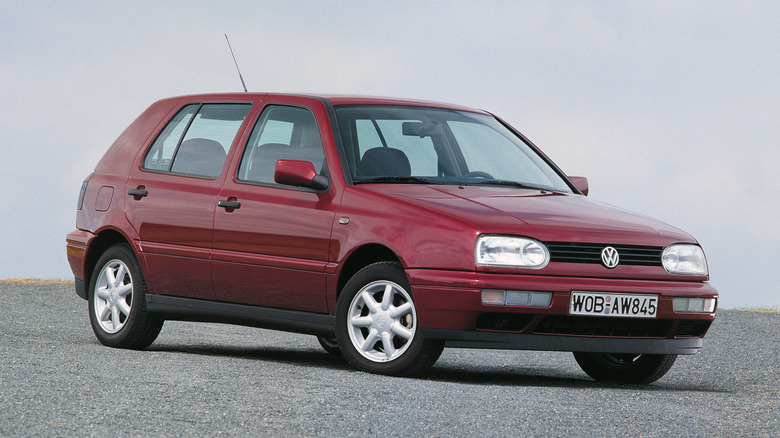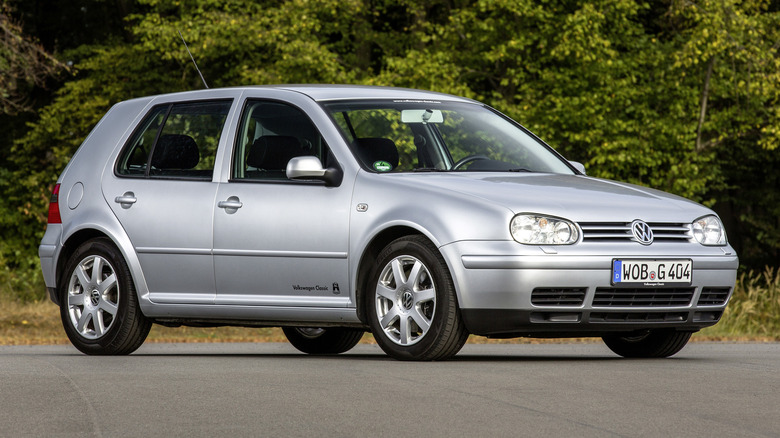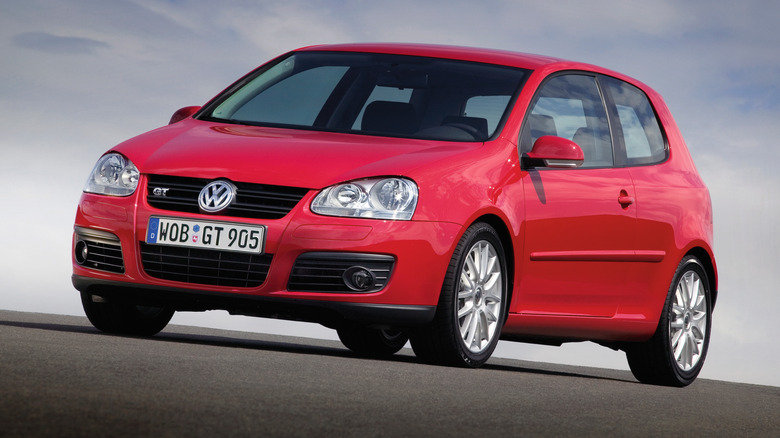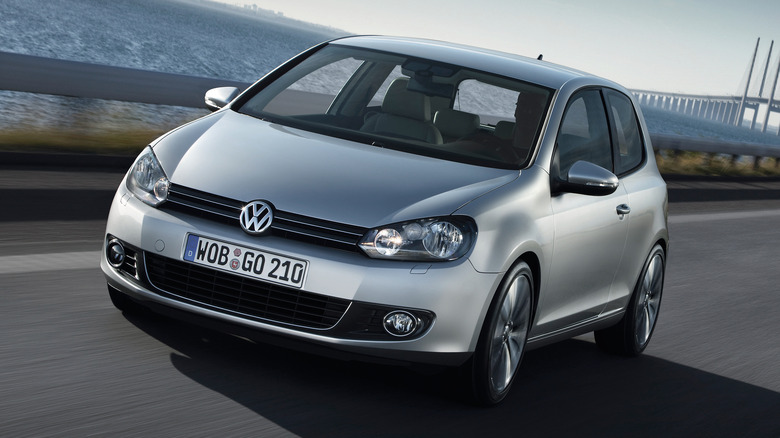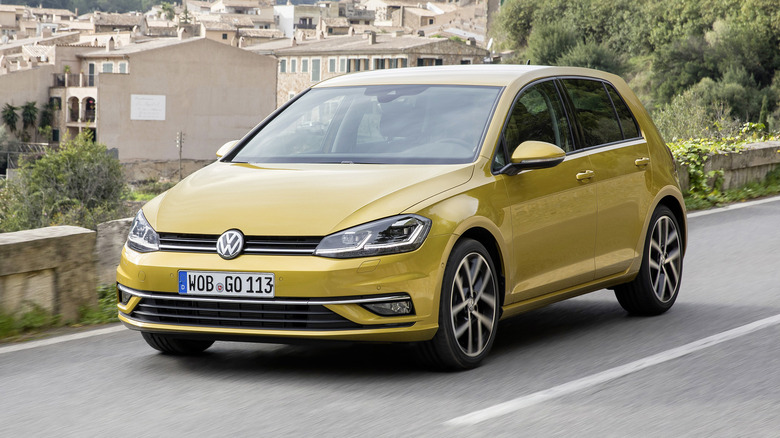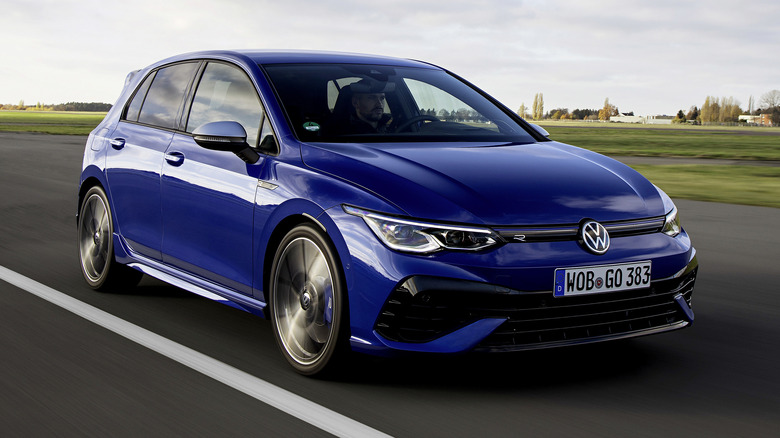This Is The Volkswagen Golf At 50: From Mk1 To Mk8
Many generations of the Volkswagen Golf can be found parked on streets across the world, but it's particularly popular in Europe, where it's remained a bestseller for many decades. As a result of this enduring popularity, over 37 million examples of the car have left VW's global factories, with over 20 million of those produced at the brand's Wolfsburg factory alone. That's enough to make the Golf the bestselling Volkswagen car ever, comfortably eclipsing the Beetle's lifetime sales of 21.5 million.
March 29, 2024 marked exactly 50 years since the car's introduction, and even after all that time, various models of the latest eighth-generation Volkswagen Golf continue to roll out of the same German factory that produced the original. However, while its production location might have remained the same, almost everything else about the Golf has changed over that time. It's grown larger, more powerful, more complex, and inevitably more expensive. Yet, it still remains the vehicle of choice for hundreds of thousands of buyers every year.
Mk1: 1974 - 1983
The Golf was created out of necessity for Volkswagen. Its previous bestseller, the Beetle, was rapidly being drowned out of the market by newer, more innovative rivals, and it needed a clean sheet design to reclaim its competitiveness. The man tasked with creating that design was Giorgetto Giugiaro. The Golf became one of the best-known designs of his career — its front-engine, front-wheel drive layout was a radical departure from the Beetle's rear-engine layout.
Its efficient packaging and attractive pricing quickly made it the sales hit that VW had hoped for, but the automaker wasn't content to rest on its laurels. Just one year after the Golf's initial launch in 1974, VW unveiled a sportier version of the car, christened the Golf GTI. It boasted around 108 hp from its 1.6-liter four-cylinder engine and featured several styling tweaks over the standard car including the distinctive red accents on the grille. The GTI helped usher in the hot hatch era, turning the Golf into more than just one of the most reliable Volkswagen models ever made: In top-spec form, it was an aspirational car too.
Mk2: 1983 - 1991
The unbridled success of the original Mk1 Golf meant that Volkswagen was reluctant to change the winning formula too much for the Mk2. Instead of an overhaul, a number of iterative improvements were made, with the improved build quality being the one that matters most to collectors today. The Mk2 was larger and heavier than its predecessor, and in base spec form, it was achingly slow. The GTI, however, was the opposite, being both sharper to drive and more powerful than its predecessor.
More than 6 million examples of the Mk2 Golf were produced over the near-decade it was on sale, with a variety of lesser-known variants built alongside the mainstream hatchback. Among the most unique was the Golf Country, a precursor to the modern crossover that added four-wheel drive, a lift kit, and off-road-inspired plastic cladding to the regular Golf. It only ever sold in small numbers — less than 8,000 examples were ever produced — and today it maintains a cult fanbase.
Mk3: 1991 - 1997
While the Mk2 Golf had sold well throughout most of its life in Europe, it lost significant ground in America, where an onslaught of new cars from Japanese automakers had taken the lion's share of the small car market. The Mk3 was designed to claw back some of that lost appeal and keep up with the fresh crop of small cars that had launched back home in Europe in the early '90s. Volkswagen had more competition than ever, and in trying to appeal to everyone, the Mk3 lost the distinctiveness that made the original car such a hit.
The Golf's new design was a lot less boxy and much more in keeping with the prevailing design trends in Europe at the time. It was politely referred to by reviewers at the time as conservative, and its styling hasn't become much more appealing with age. Its range of powertrains was also mostly unremarkable, with even the GTI failing to appease enthusiasts in the way its predecessors had. Despite its mixed reception, the Mk3 succeeded in boosting VW's sales numbers, selling around 4.8 million units over its production run.
Mk4: 1997 - 2003
Volkswagen's conservative tendencies had started to change by the late '90s. The company was coming around to the idea that buyers wanted something new and interesting if they were to keep buying the Golf in millions. The Mk4, unveiled in 1997, debuted with sharper styling and an overhauled range of powertrains, and proved to be the right car at the right time. Around 4.9 million examples were sold over its time on sale.
The most interesting variant of the Mk4 Golf from an enthusiast's perspective didn't arrive until later in its production run. The GTI was considered to be a slight letdown compared to earlier models, but it remained the top-spec variant in the lineup until 2002 when the top-spec R32 was unveiled. The European exclusive R32 represented a step above the GTI in both performance and price, dialing up the heat in the hot hatch wars that had been supercharged by new entries like the Ford Focus RS and Honda Civic Type-R.
OF NOTE: While standard production ended in 2003, additional extended production models appeared via FAW-Volkswagen, Volkswagen Brazil, and Volkswagen Canada for several more years.
Mk5: 2003 - 2008
One of the shortest-lived Golf generations, the Mk5 arrived in 2003 (with model year 2004) and was replaced in 2008. In its relatively brief time in production, the fifth generation managed to reaffirm enthusiasts' faith in the Golf GTI, which launched with a slew of improvements over its predecessor. It was notably sharper to drive and faster than the outgoing car, which it desperately needed to be, as an even more packed field of competitors had emerged over the time the Mk4 GTI was on sale.
Everyday variants of the Golf had also been significantly improved for the launch of the Mk5. The new car featured improved rigidity and revised suspension while adding new safety features to reinforce its family hauling credentials. The diesel engines introduced in the previous generation had also proved popular in Europe, and so for the fifth generation, Volkswagen attempted to convince customers in North America that diesel was the future. These attempts weren't entirely successful, but the gasoline Golf still sold in high enough numbers to justify its continued presence in the U.S. market.
Mk6: 2008 - 2012
The Mk6 was in production for even less time than the Mk5, but it still shifted 3.6 million units during its time on sale. It built on the success of its predecessor, concentrating on offering a wider range of tech and safety features in a bid to push its image upmarket. It also saw the return of the top-spec Golf R variant — this time without the "32" moniker — with more than 260 hp on offer. Older Golf models had tended to eschew cutting-edge tech in a bid to keep prices down, but the Mk6 saw the debut of several driver assistance technologies that have become ubiquitous today.
Features like hill start assist and park assist were made available for the Golf for the first time, as well as a fuel-saving start-stop system. Efficiency was even more of a focus for the Mk6 than previous generations, with Volkswagen aiming to compete with the premium German brands when it came to mpg figures. It also benchmarked premium brands when fashioning its interior, which was noticeably more plush overall than the outgoing model, even if it was never going to be confused for a Mercedes-Benz or BMW.
Mk7: 2012 - 2020
Gas-powered variants of the Mk7 Golf were largely iterative improvements over their predecessors: Reduced weight, added safety tech, and updated styling were the headline changes. The Golf continued to sell well across Europe, its main market, and so there was no need for a radical overhaul. A range of gasoline and diesel variants were offered, although the diesel models became significantly less popular in the wake of Volkswagen's infamous Dieselgate scandal.
The resulting fines from the scandal forced Volkswagen to invest in greener technologies, but the automaker was already moving ahead with its plans for zero-emissions versions of the Golf before the scandal emerged. The first production electric Golf, the e-Golf, was launched in 2014, and continued to be built until the end of Mk7 production in 2020. In total, more than 145,000 examples of the car were sold, mainly in Germany and other EV-friendly countries such as Norway. The ID.3 later replaced the e-Golf as VW's compact EV, with several more models added to the electric ID range over the following years.
Mk8: 2020 - Present
The latest and greatest generation of the Volkswagen Golf launched in 2020, and it didn't have the most ideal of starts. The last-minute cancellation of the Geneva Motor Show due to the pandemic forced Volkswagen to conduct its first-ever "virtual motor show." The initial production of the car was also negatively affected. Nonetheless, when reviewers were finally able to get their hands on the car, the consensus was that the Mk8 was better than ever.
SlashGear called the top-spec VW Golf R "hot hatch heaven" in our 2022 review, praising its compelling mix of practicality and performance. What the future holds for the Golf line is hard to predict: The time when electrification becomes the default option for all new cars is still a long way off, if it ever arrives. As such, although the Golf may eventually be phased out in favor of the ID range, in much the same way as the Beetle was sidelined to make way for the Golf, that's by no means a foregone conclusion. For now, the bestselling European car in history appears to be in rude health, a full 50 years on from the original's debut.
